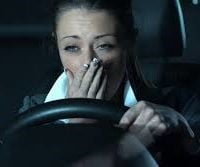
Working the night shift is a known health hazard. Scientists theorize that staying awake at night goes against our natural circadian rhythm, the body’s internal clock, which is why people who work after hours are more prone to heart attacks, heart disease, diabetes, obesity, stroke and depression.
According to Anna Almendrala, who is a Healthy Living editor for the Huffington Post, the drive home after a night shift can be hazardous too, which confirms a small but compelling new study involving a global team of researchers from Boston and Australia. They conducted daytime driving tests on a closed driving track among 16 night shift workers who had just come off the job. The study found that the volunteers’ driving was dangerously worse after work than if they’d had a full night’s sleep.
Six of the participants (37.5 percent) had 11 near-crashes during the driving test, which required the safety supervisors to use their emergency brakes to prevent a collision. The researchers terminated the two-hour driving test early for seven participants (43.8 percent) over concerns for the safety of everyone in the car. Based on the numbers, the researchers suggest that the night shift workers and their employers find a way for workers to get home that doesn’t involve getting into the driver’s seat of a car, or come up with strategies to reduce drowsiness after a shift.
“These findings help to explain why night shift workers have so many more motor vehicle crashes than day workers, particularly during the commute home,” said study co-author Dr. Charles A. Czeisler, chief of the Division of Sleep and Circadian Disorders at Brigham and Women’s Hospital in Boston, in a statement.
The study is the first time researchers have assessed the impact of night shift work on driving in real vehicles, as opposed to using a simulated method.
After sleeping almost eight hours the night before with no shift work, the 16 participants had zero near-crashes — and all finished the agreed-upon two-hour driving test. But when participants went through the same test after a night shift (at this point, it had been an average of 13 hours since their last sleep), there was a statistically significant increase in lane drifting, slow eye movements and “microsleep episodes” — temporary shut-eye that last more than three seconds.
All of the near-crashes occurred after at least 45 minutes into the driving test. About 15 percent of workers in the U.S. drive more than 45 minutes each way of their commute, the study notes. The researchers wrote that the safety supervisors who accompanied participants on these driving tests could tell that the workers were drowsy and impaired within the first 15 minutes of the drive.
The experiment, published Monday in the journal Proceedings of the National Academy of Sciences, was conducted on a driving track that belongs to vehicle insurer Liberty Mutual Insurance. In an emailed statement to The Huffington Post, the Liberty Mutual Research Institute for Safety said that they hope “a deeper understanding of the mechanisms involved in drowsy driving can lead to effective prevention strategies that would help alleviate this major public health concern.”
There are several limitations of the study. One in particular is that the driving tests took place on a closed driving track with a simple design relative to real streets. Even though this means the participants were driving real cars, they were not encountering real-life commuting challenges like the behavior of other cars, pedestrian traffic and complex road navigation. The additional challenges of a real commute may actually serve to enhance wakefulness in drivers, as the higher stakes might force them to be more alert, the researchers note.
The study’s observation methods — like having to stop the driving test every 15 minutes to survey the driving participants, asking the drivers to attach EEG electrodes to their heads to measure the microsleep episodes and making them wear special glasses to measure the speed of their eye movements and how long they blinked — may have artificially made the participants more alert than they’d normally be on a real drive home. Yet, Czeisler points out, all these conditions, the monitoring measures and added social pressure, couldn’t keep about 44 percent of participants alert enough to complete the driving test.
“This was real driving in an actual car, putting everyone involved in the experiment at considerable risk,” he said. “And yet the impairment still came through, which shows just how strong the biological drive for sleep is.”
